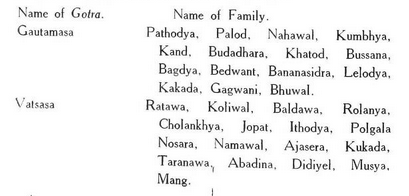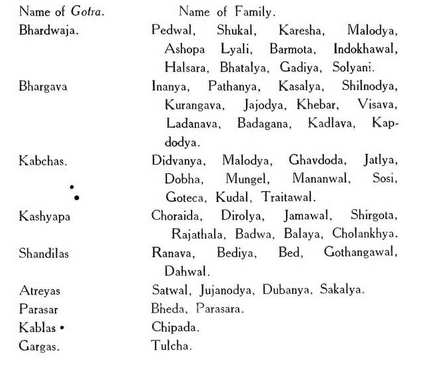Brahmans-Marwadi: Deccan
Contents |
Brahmans-Marwadi
This article is an extract from THE CASTES AND TRIBES OF H. E. H. THE NIZAM'S DOMINIONS BY SYED SIRAJ UL HASSAN Of Merton College, Oxford, Trinity College, Dublin, and Middle Temple, London. One of the Judges of H. E. H. the Nizam's High Court of Judicature : Lately Director of Public Instruction. BOMBAY THE TlMES PRESS 1920 Indpaedia is an archive. It neither agrees nor disagrees |
The Marwadi Brahmans found in H. H. the Nizam's Dominions are emigrants from Northern India, especially from Malwa and, as such, may be ranked with the five Gauras, whom they almost resemble in their customs and usages. They have six sub-divisions, which are grouped under one designation " Chhannyati," meaning six castes. Regarding their origin, it is said that Maharaja Jayasingh of Jaipur performed a horse sacrifice (Ashwa Medha), to which he invited a vast concourse of Brahmans from different countries and requested them to eat together. The Brahmans, as a matter of course, refused compliance. The Maharaja, thereupon, forced the Brahmans of his own kingdom to be united by interdining, and the six classes, thus brought together, have been known as " Chhannyati Brahmans."
Origin
Dayamas, or Dahimas, claim to be descended from the sage Dadhichi, who was the son of Atharwana and the grandson of Brahma. Dadhichi had a son by his wife, Satyaprabha, who deposited the child, while still in an embryonic state, under a pipal tree (Ficus religiosa) and joined her husband in heaven. The goddess Maya developed the embryo, nursed the child and named him Pippalayan, after the pipal tree under which he was born. Pippalayan had twelve sons, who were married to the twelve daughters of the king Mandhata. From these twelve sons sprung 172 families of Dahima Brahmans, of which only 85 are extant at the present day.
The Dahimas belong to the Madhyandina Shakha of the white Yajmoeda, with three and five pravaras. They are Smarthas by sect and worship Panchayatanam, or the five principal deities of the pantheon. ' Some of them are very learned in the sacred lore. Their women wear ivory bangles. Their tutelary deity is Dudh Muth, of whom there is a temple at the village of Mangled, in Nagor (Malva), where a large fair is held annually in honour of the deity.
The Parikh trace their lineage to the sage Parashara. Like the Dahimas they are white Yajurvedis of the Madhyandina Shakha. They are said to have 103 exogamous sections. They are, mostly, Vaishanavas, of the Vallabha sect. Their women wear glass bangles after they are married.
The Gujar Gowds are believed to be an offshoot from the Gaur Brahmans of Bengal. They are Shukla Yajurvedis, belong to the Shaiva sect, and minister to the spiritual needs of the Marwadi Mahajans. They claim descent from the sage Gautama.
The Saraswats are rarely found in these Dominions. Their tradi- tion is that Brahma had a daughter named Saraswati, who was married to Dadhicha Rishi. They had a son who was named Saraswat and became the founder of this clan of Brahmans. The Saraswats are Saivaits in their creed.
The Khandelwads take their name from the village of Khandela, in the Jaipur State. They are divided into 53 sects, which are the names of localities they dwell in.
Marriage
With the Chhannyati Brahmans the eponymous gotras are only nominal and their marriages are regulated by exoga- mous groups, purely of the territorial type. In other words, inter- marriages are allowed between parties having the same gotra or eponym, but they are not allowed between persons having the same surname. Girls are married both before and after they have attained the age of puberty, and adult marriage, which is strictly prohibited by the Brahman caste in general, is in vogue among the Chhannyali tribes. This is certainly a strange departure from the orthodox usage and gives credence to the story of their having been manufactured by the Maharaja Jayasingh some hundred and fifty years ago. A heavy bride- price is sometimes paid to the parents of the girl. The marriage procession is formed at the house of the bridegroom and conducts him, riding on a mare, to the house of the bride. There the whole party is entertained. At the auspicious moment appointed for the ,. wedding, the bride and the bridegroom are seated under the weddirig canopy, a sacrificial fire is kindled before them and appropriate mantras are recited by the priest. The young couple walk seven times round the holy fire, always keeping their right hands towards it. This forms the essential or binding portion of the ceremony. Widows are not allowed to marry again, nor is divorce recognised by the caste. A man may marry as many wives as he can afford to maintain. Marwadi Brahmans officiate as priests to the Marwadi Mahajanas, or trading classes, and other lower classes such as Sonar, Shimpi, Barbers and others. Some of them are traders and money-lenders. As priests to the lower classes they are notorious for their rapacity and greed. A few of them are eminent astrologers and learned pandits.
Internal Structure
The section names of the Dayama Brahmans are appended and may serve as an illustration of the exogamous sections of the entire Chhannyati caste. Name of Gotra. Name of Family.

